When it comes to trend following indicators, knowing the best ones is crucial for your trading success.
Imagine having a toolkit of proven indicators at your disposal, guiding you through market trends and potential opportunities.
By understanding how each indicator functions and when to use them, you can navigate the complexities of the market with confidence and precision.
These indicators serve as your compass, leading you towards profitable trades and helping you stay ahead of the curve.
Simple Moving Average (SMA)
When analyzing trends in financial markets, the Simple Moving Average (SMA) serves as a fundamental indicator for evaluating price dynamics. The SMA calculates the average price over a specific number of chosen price bars, commonly using closing prices. It's effective for assessing the strength of the current trend and determining potential trend continuation or reversal.
However, the SMA may be less effective in sideways or rangebound markets where price movements are limited. Traders often combine the SMA with other indicators or analysis techniques for more precise trend assessments. By providing a smooth representation of price trends over time, the SMA offers valuable insights into the overall direction of the market, aiding traders in making informed decisions.
Exponential Moving Average (EMA)
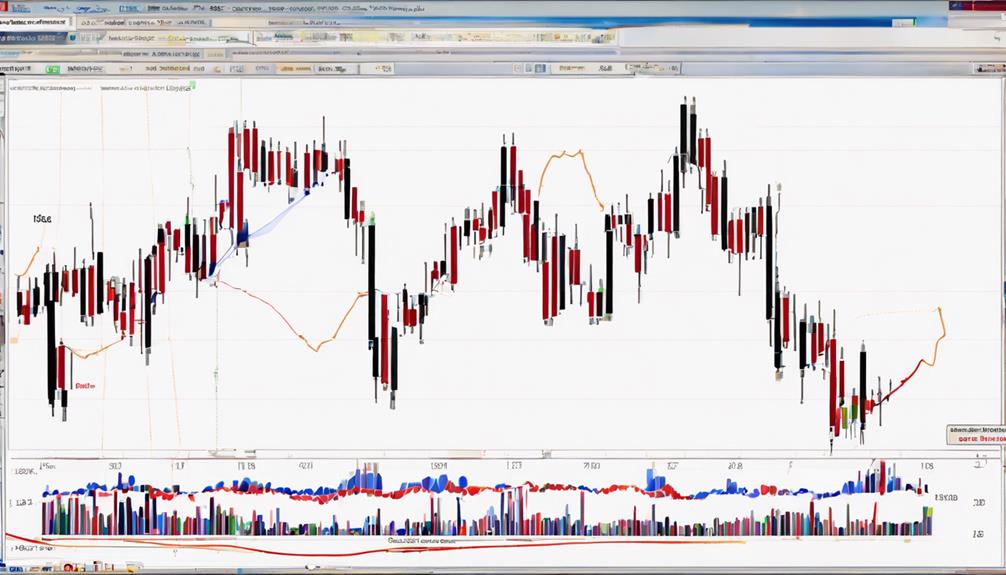
When considering the Exponential Moving Average (EMA), it's crucial to understand its calculation method, trading strategies, and how it compares to the Simple Moving Average (SMA).
EMA's calculation involves applying a multiplier to the previous EMA value and the current price, emphasizing recent data for faster responses to price changes.
This indicator is favored for capturing short-term trends and signaling potential reversals or continuations in the market.
EMA Calculation Method
Utilizing the Exponential Moving Average (EMA) calculation method in technical analysis provides a responsive indicator that places more emphasis on recent price data, making it a valuable tool for analyzing short-term price trends. The EMA formula incorporates a smoothing factor that reacts faster to price movements than the Simple Moving Average (SMA).
EMA is effective for identifying trend reversals and crossovers in fast-moving markets. This indicator is popular for generating buy/sell signals based on short-term price trends. Traders commonly combine EMA with other indicators to confirm trend direction and strength, enhancing their overall analysis.
The EMA's ability to swiftly adapt to price changes makes it a versatile tool for traders seeking to capitalize on short-term market movements.
EMA Trading Strategies
Employing exponential moving averages (EMAs) in trading strategies enhances responsiveness to recent price changes, making them crucial tools for timely entry and exit decisions. Traders utilize EMAs to identify short to medium-term trends, relying on EMA crossovers for trend confirmation and entry/exit signals.
Commonly used combinations of EMAs, like the 20-day, 50-day, and 200-day EMAs, help in confirming trend direction. EMA crossovers, where shorter EMAs intersect longer EMAs, are significant indicators for traders, signaling potential changes in trend direction.
EMA Vs. SMA
Enhancing your understanding of moving averages, particularly by comparing the Exponential Moving Average (EMA) with the Simple Moving Average (SMA), can provide valuable insights into their distinct characteristics and implications for trading strategies.
When comparing EMA and SMA, consider the following:
- EMA gives more weight to recent data, making it more responsive to price changes.
- EMA generates faster signals than SMA but may also result in more false signals.
- Combining different EMAs, such as 20-day, 50-day, and 200-day, can enhance trend analysis accuracy.
Understanding the nuances of EMA and SMA can help you make more informed decisions when analyzing trends and executing trades.
Average Directional Index (ADX/DMS)
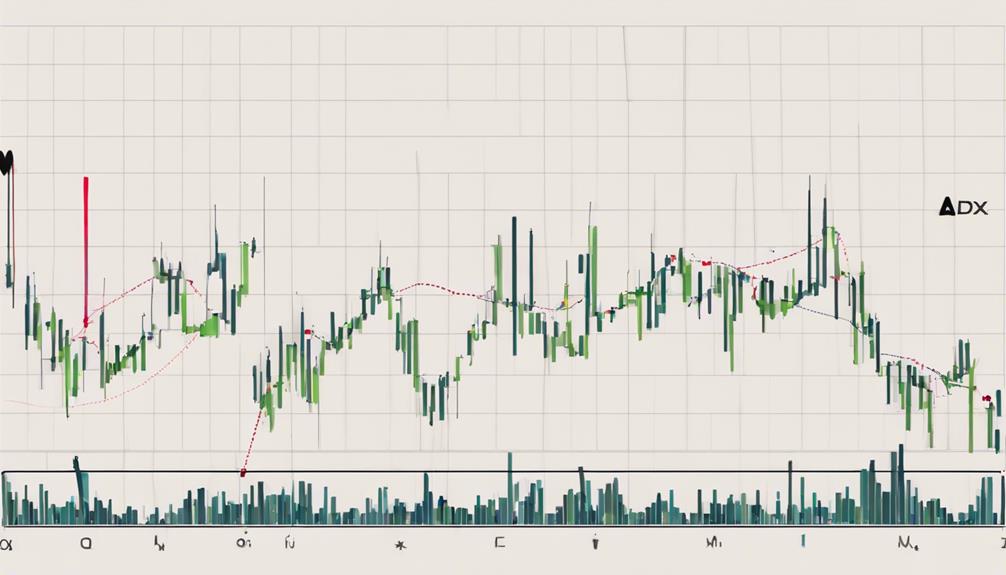
The Average Directional Index (ADX) quantifies trend strength by utilizing the Positive Directional Indicator (+DI) and Negative Directional Indicator (-DI) to determine the prevailing direction. ADX values range from 0 to 100, with readings above 25 indicating a strong trend and values below 25 suggesting a weak or rangebound market.
This indicator is effective in filtering signals and reducing noise in trending markets. Traders often use ADX in combination with other indicators to confirm the strength and direction of a trend.
Moving Average Convergence-Divergence (MACD)

As you explore the Moving Average Convergence-Divergence (MACD), delve into its role as a prominent trend-following indicator that analyzes moving averages to detect potential shifts in market trends.
MACD is made up of the MACD line and the signal line, with crossovers and divergences serving as buy and sell signals.
The MACD histogram illustrates the gap between the MACD line and the signal line, indicating momentum changes.
Traders commonly rely on MACD to confirm trend direction, evaluate trend strength, and determine entry and exit points. Keep in mind, while MACD excels in identifying trends, it might lag in fast markets and produce false signals in sideways markets.
Parabolic Stop and Reverse (Parabolic SAR)
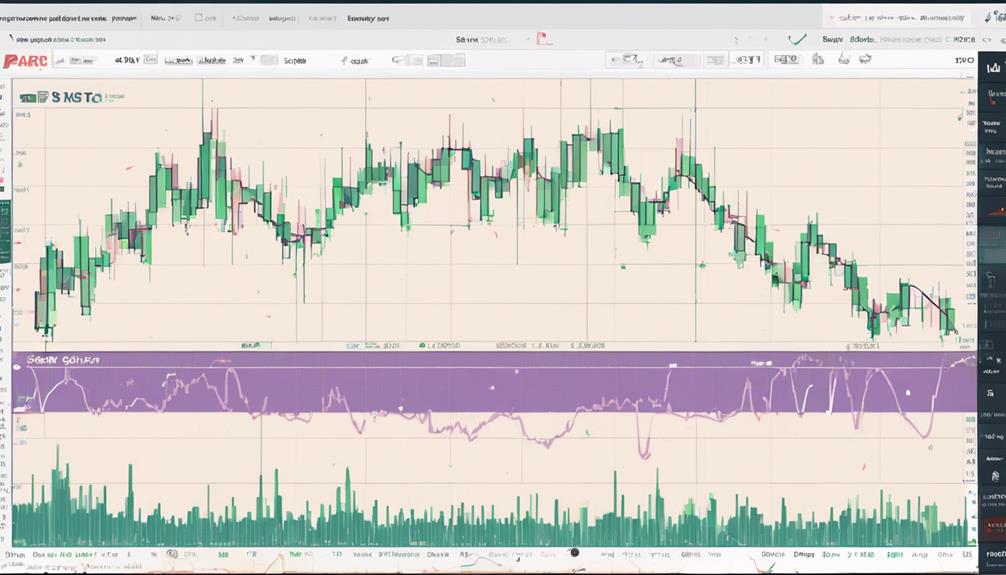
When considering the Parabolic Stop and Reverse (Parabolic SAR) indicator, it's crucial to understand its SAR calculation method, interpretation, and signals. By grasping these key aspects, you can effectively implement this indicator in your trading strategy.
Utilizing Parabolic SAR can assist you in identifying potential trend reversals and managing your positions based on the market's direction.
SAR Calculation Method
Calculating stop and reverse points based on price momentum, the Parabolic SAR indicator displays dots above or below the price chart to signal potential trend reversals. Understanding the SAR calculation method is crucial for making informed decisions in trend following strategies. Here are some key points about the SAR Calculation Method:
- The indicator adjusts its dots closer to the price as trends accelerate.
- Traders utilize Parabolic SAR to manage trailing stops effectively.
- It helps confirm trend directions, aiding traders in staying on the right side of the market.
Mastering the SAR calculation method empowers traders to navigate trends efficiently and make well-informed decisions when trading.
Interpretation and Signals
The Parabolic Stop and Reverse (Parabolic SAR) indicator dynamically determines support and resistance levels based on price movements, offering insights into trend direction and potential reversal points through its distinctive dots placement on the price chart. When the dots switch position, it indicates a potential trend reversal, prompting traders to manage positions and set stop-loss orders accordingly.
This tool is valuable for confirming trend direction and identifying potential reversal points in the market. Parabolic SAR is most effective in strong trending markets, where it helps traders stay in winning positions longer, but may be less reliable in sideways or rangebound conditions where false signals can occur.
Utilize Parabolic SAR judiciously to navigate different market scenarios effectively.
Implementing in Trading
Implementing the Parabolic Stop and Reverse (Parabolic SAR) indicator in your trading strategy can enhance trend analysis and risk management capabilities. When using this indicator, consider the following:
- Trend Direction: The Parabolic SAR dots above or below price bars indicate the trend direction.
- Risk Management: Utilize Parabolic SAR for setting stop-loss levels to manage risk effectively.
- Potential Reversal: Be cautious of potential reversals signaled by the Parabolic SAR, especially in strong trending markets.
Integrating Parabolic SAR with other indicators and recognizing price patterns can help filter out false signals and improve the accuracy of your trend analysis. By understanding how to interpret the Parabolic SAR, traders can make more informed decisions regarding market trends and potential reversals.
Relative Strength Index (RSI)
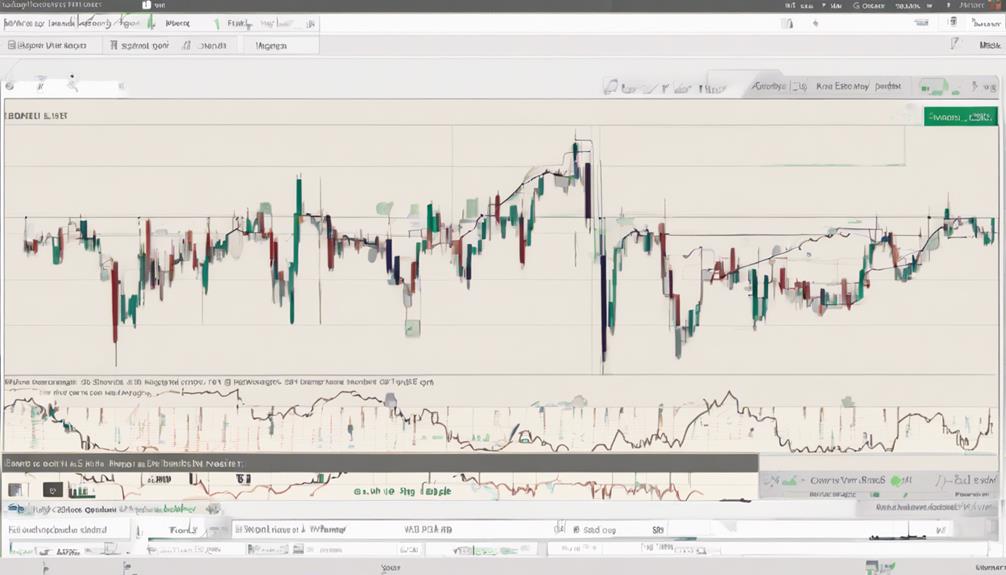
How does the Relative Strength Index (RSI) allow traders to gauge the speed and change of price movements?
The RSI indicator, a momentum oscillator, provides insights into market conditions by identifying overbought and oversold conditions.
Readings above 70 suggest overbought levels, while those below 30 indicate oversold levels.
Traders utilize RSI to spot potential trend reversals and confirm existing trends, offering reliable signals for entering or exiting trades.
By assessing the strength of price movements, RSI helps traders avoid false signals and make informed decisions.
Additionally, combining RSI with other indicators can enhance trading strategies, offering a more comprehensive view of market dynamics and potentially improving trade outcomes.
Bollinger Bands
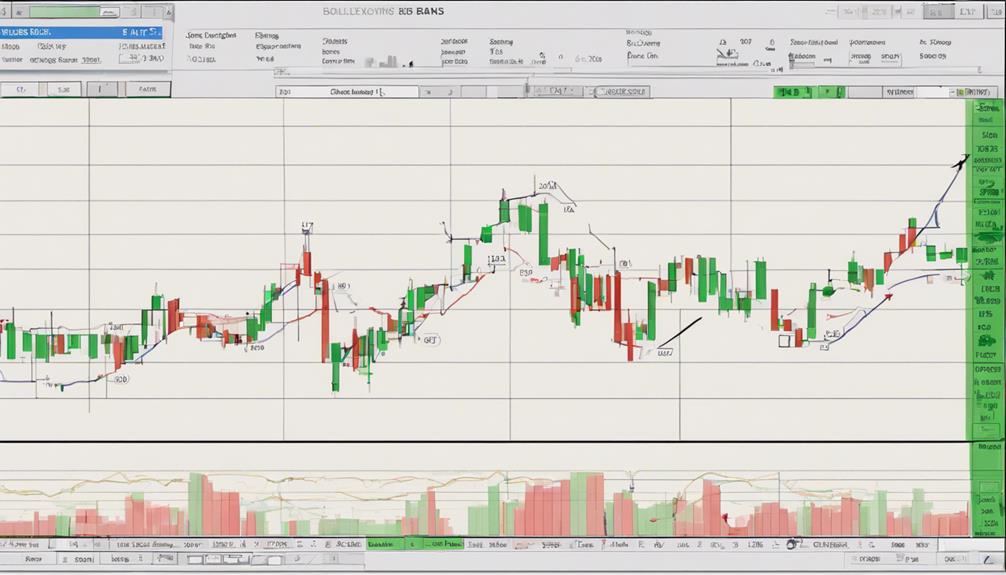
Bollinger Bands are a widely used tool in technical analysis that offer insights into market volatility and potential price movements. Understanding the Bandwidth and Volatility Relationship can help you gauge the intensity of market fluctuations and identify periods of heightened price action.
Additionally, Bollinger Bands can signal potential price reversals, providing traders with valuable information for decision-making.
Bandwidth and Volatility Relationship
During periods of high volatility, the Bollinger Bands widen, indicating increased price movement variability around the simple moving average. This relationship between bandwidth and volatility is crucial for traders looking to anticipate market movements effectively. Understanding this dynamic can provide valuable insights into potential breakout opportunities and trend reversals.
Here's why the bandwidth and volatility relationship matters:
- Bollinger Bands offer visual boundaries for price movements, helping traders identify extreme market conditions.
- The width of the Bollinger Bands expands and contracts based on market volatility levels.
- Traders use Bollinger Bands to assess the strength of a trend and pinpoint possible price reversal points.
This knowledge empowers traders to make informed decisions when navigating the markets using Bollinger Bands.
Signal for Price Reversal
Indicators like Bollinger Bands provide traders with a signal for potential price reversals by analyzing volatility and identifying overbought or oversold market conditions.
These bands consist of a simple moving average (SMA) surrounded by upper and lower bands that are determined by standard deviations from the SMA. When prices approach the upper band, it indicates overbought conditions, while nearing the lower band suggests oversold conditions. Price touching or crossing these bands can signal either a reversal or a continuation of the existing trend.
Traders often combine Bollinger Bands with other indicators to validate reversal signals and make well-informed trading choices. By understanding these dynamics, traders can better navigate trends and capitalize on market opportunities effectively.
Ichimoku Cloud
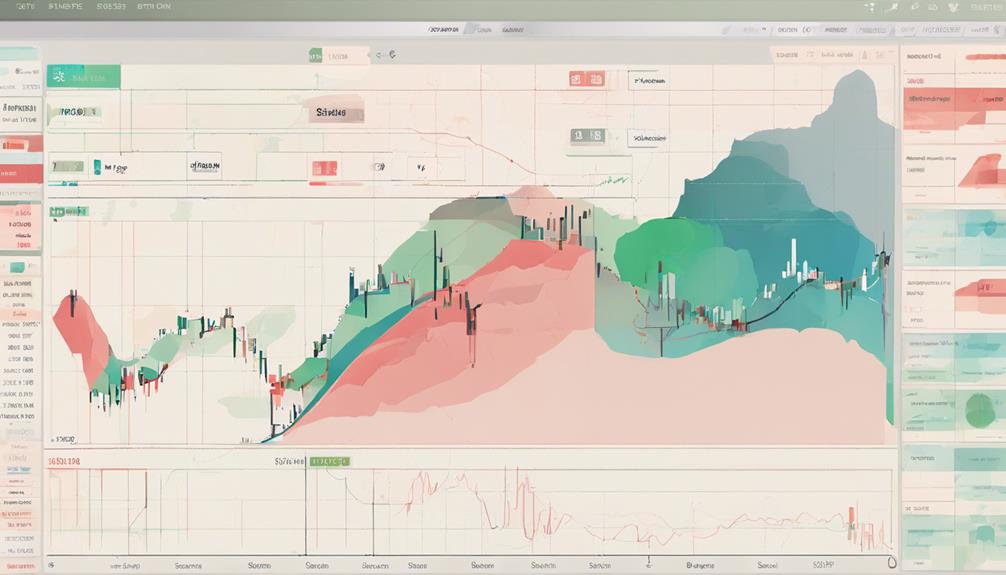
The Ichimoku Cloud indicator, devised by Goichi Hosoda in the 1960s, offers a comprehensive approach to trend following with its five distinct components. This indicator provides valuable insights into market trends and potential reversals.
Here are some key points about the Ichimoku Cloud:
- The Tenkan-sen and Kijun-sen lines can signal buy or sell opportunities through their crossovers.
- The Senkou Span A and Senkou Span B form the cloud, indicating future support and resistance levels.
- The Chikou Span reflects the current price in relation to historical price action, confirming the prevailing trend direction.
Stochastic Oscillator
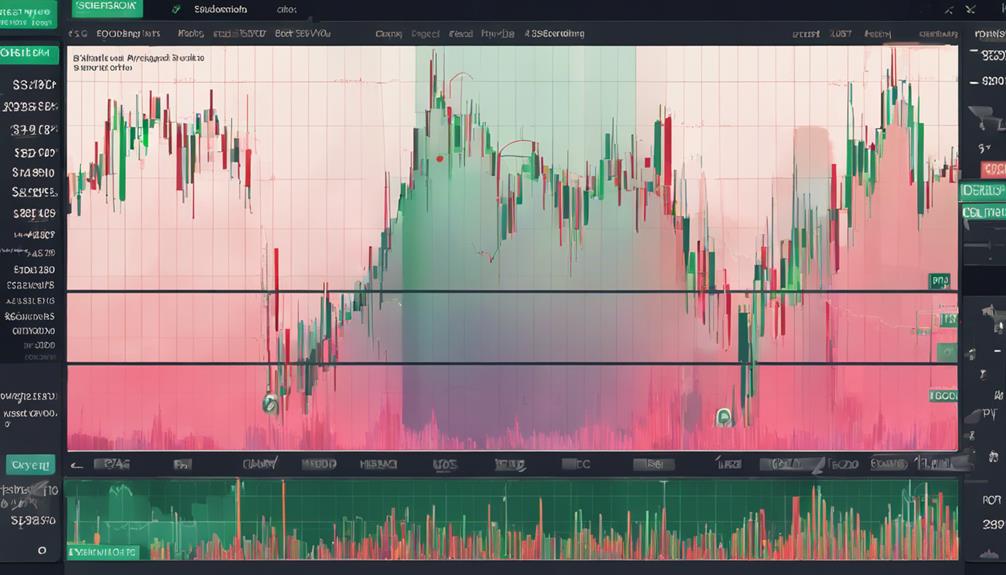
Wondering how the Stochastic Oscillator measures momentum in trading strategies?
This momentum indicator evaluates the closing price in relation to a specific price range over a set period. It comprises two lines, %K reflecting the current price position within the range, and %D, a moving average of %K.
Ranging from 0 to 100, values exceeding 80 suggest overbought conditions, while those below 20 indicate oversold conditions. Traders leverage the Stochastic Oscillator to pinpoint potential trend reversals, detect price-oscillator disparities, and identify overbought/oversold levels for precise entry/exit points.
To amplify its efficacy in trend following strategies, it's common practice to combine the Stochastic Oscillator with other indicators such as moving averages or trend lines.
Fibonacci Retracement Levels
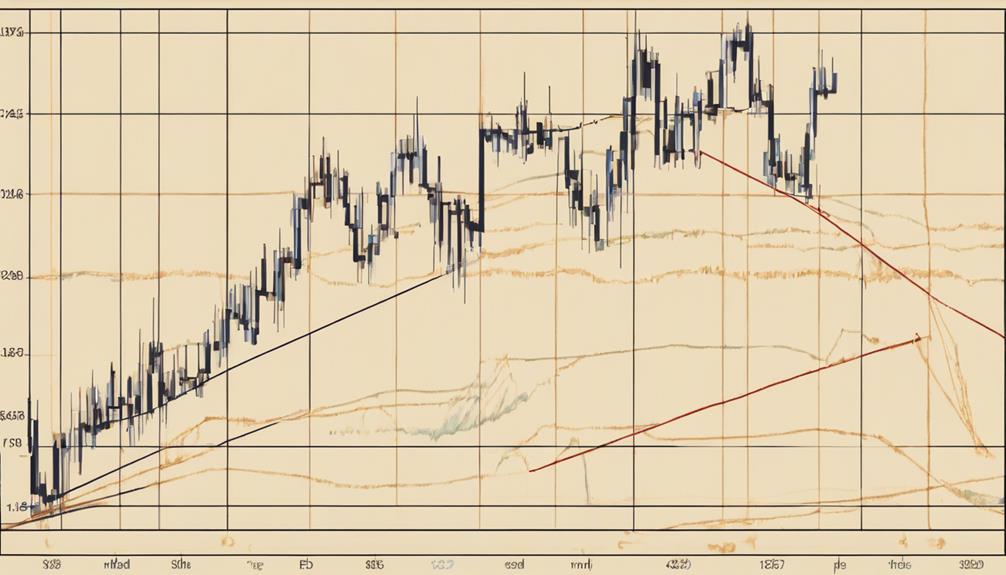
Fibonacci retracement levels, horizontal lines derived from the Fibonacci sequence, serve as crucial indicators for identifying potential support and resistance levels in trading strategies.
When utilizing Fibonacci retracement levels, traders can pinpoint potential reversal points in a trending market. Key Fibonacci levels such as 23.6%, 38.2%, 50%, 61.8%, and 100% provide significant insights into possible support and resistance areas.
Additionally, the 50% retracement level, although not a Fibonacci number, holds importance as a psychological level in trading. These levels are commonly used alongside other technical indicators to validate potential trend reversals or continuations, enhancing the overall effectiveness of trading strategies.
What Are the Advantages of Using Basic Trend Following Indicators Compared to More Complex Ones?
When it comes to trading, simplicity can be key. Using the best basic trend following indicators, such as moving averages and the relative strength index, can offer clear signals without the noise. They are easy to interpret and apply, making them a popular choice for many traders.
Frequently Asked Questions
Which Is the Best Trend Indicator?
When choosing a trend indicator, consider your trading preferences, goals, and the market conditions. Combining indicators like Moving Averages, Bollinger Bands, MACD, RSI, and ADX can enhance accuracy. Test different indicators to find what works best for your strategy.
Which Is the Best Trend-Following Strategy?
You'll find the best trend-following strategy by blending indicators that resonate with your trading persona. Combining moving averages, Bollinger Bands, MACD, RSI, and On Balance Volume can amplify your trend-spotting prowess.
Which Technical Indicator Is the Most Accurate?
When identifying the most accurate technical indicator for trend following, consider your trading style and preferences. Moving averages like the 200-day EMA or oscillators such as the RSI and MACD are popular choices. Combine indicators for confirmation signals and backtest for accuracy.
What Is the Most Accurate Buy Sell Signal Indicator?
When determining the most accurate buy sell signal indicator, consider combining indicators like MACD, RSI, and Stochastic Oscillator. Backtest and optimize settings for your trading style. Market conditions, asset volatility, and risk tolerance are crucial factors in making informed decisions.
Conclusion
In conclusion, mastering the 10 best trend following indicators is like having a well-equipped toolbox for navigating the dynamic landscape of the market.
By utilizing these indicators effectively and consistently, traders can enhance their decision-making process, identify profitable trends, and optimize their trading strategies for success.
Remember, just like a skilled craftsman relies on the right tools, traders rely on these indicators to guide them towards profitable opportunities in the market.
Happy trading!
